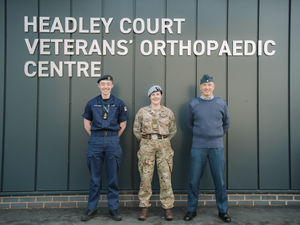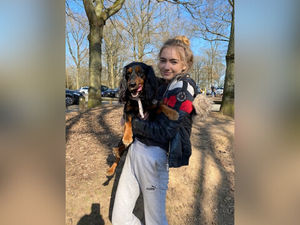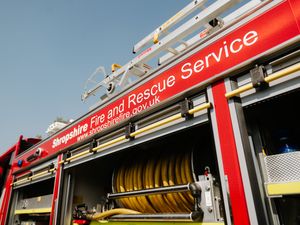Pride and sadness as Lynx bows out at RAF Shawbury
Age finally caught up with the Lynx helicopter as it embarked on a farewell tour, taking in RAF Shawbury along the way.

The aircraft flew into the Shropshire airbase, where it has for years been a familiar sight.
With a distinguished career spanning nearly 40 years, the Lynx entered into service in 1978 and since then, as the Army’s longest serving helicopter, has been used for a variety of tasks.
RAF Shawbury is a helicopter training base, with former students including Prince Harry. And astronaut Tim Peake honed his flying skills as an instructor by flying the Lynx.
To mark its decommissioning from service on January 31, the Army Air Corps flew four of the last remaining Lynx helicopters from RAF Odiham in Hampshire, passing through RAF Shawbury. at around lunchtime as part of its commemorative tour
Commanding Officer of 657 Squadron, Major James Peycke, said: bidding “farewell to the iconic machine” is a huge moment for everyone who has flown the Lynx over the years.“It is hugely emotional saying goodbye to the Lynx after six years of flying and it carves out a big chunk of your heart.”
Describing the aircraft as “hugely manoeuvrable”, Maj Peycke said there is “never a dull day when you are flying” one.

The four Mk9 Lynx lifted off to thunder around the UK’s skies, taking in sites and locations including Shawbury, Yeovil, Middle Wallop and Upavon, before also flying in formation, led by a Chinook helicopter, along the length of the River Thames in central London.
Speaking before they departed, Maj Peycke, who was flying in the lead Lynx, said they would have liked to include more locations on the tour but were restricted by winter daylight hours.
When pressed on how he will feel as the wheels touch down for one of the final times at RAF Odiham, he said it would be an “incredibly emotional moment”.
“Not only does it mark the out-of-service date for the Lynx, the 75th anniversary of the squadron (657) which was formed in 1943, but also the closure of the squadron (in May) and the end of my tour as an officer commanding, so it will be an incredibly emotional moment, particularly as we come back in - I’m probably going to have a lump in my throat,” he added.
Described as a primary battlefield utility helicopter, over the decades the Lynx has also been used for destroying tanks, evacuating the wounded, gathering intelligence and providing humanitarian support.
It has been deployed on operations across the world including the jungles of South East Asia and Central America, the sub-zero Arctic and the Middle East – and has supported troops on active service in Bosnia, Kuwait, Afghanistan and Sierra Leone.
Staff Sergeant Nathan Sharples, one of the pilots flying the lead Lynx, said: when asked if the helicopter being decommissioned is a loss, said it is not, that things need to progress, and it is now “time for the old girl to retire”.“She has served us proud throughout the years.” added the 34-year-old, who has only ever flown the Lynx.
The Lynx is set to be replaced within the British Army by the Wildcat, which has more powerful engines and can operate at a higher altitude.
Air Trooper Toby Tibbitts, a ground crew specialist who has been in the military for two-and-a-half years, said this is his first and only squadron so far, and seeing the Lynx go was a “sad day” but a proud one.
Quizzed about his favourite moment involving the helicopter, he said fast roping out of a Lynx over a desert was a “pretty special experience” and one he will not forget.
He said the replacement Wildcat “seems like a good aircraft”, and that, with the positive trials and exercises, plus upgraded avionics and engines, the “future is looking bright”.
The Lynx was also used by the Royal Navy, whose helicopters went out of service in March last year after more than 41 years of operations.
As a workhorse of the military over the years, the Lynx, which carries three crew plus six troops with full kit, has also been involved in a number of tragedies during its years of service.
Famous faces were among crew
The Lynx Helicopter served the British army for more than 40 years. It was also flown by some of the most famous faces in the country.
The helicopter, used at RAF Shawbury for many years as part of training exercises, has been the British Army’s longest serving aircraft, and has had the likes of astronaut Tim Peake and Prince Harry at the controls in the past.
Major Peake was one of the Army’s top pilots who spent 18 years in the Army Air Corps, flying 30 different helicopter, including the iconic Lynx Helicoper, before being chosen as the first British astronaut to go into space.
He also worked for manufacturer Augusta Westland as a senior test pilot, flight testing Apache and Lynx Helicopters. He was a familiar face at RAF Shawbury, where he helped train a new generation of pilots.
Prince Harry also became a Lynx Helicopter pilot back in 2010, and expressed his desire to return to the front line in Afghanistan in the aircraft.
The Shawbury base has been known for the training it offers, and both Princes William and Harry, have undergone courses in Shropshire.
Prince Harry, who has served in Afghanistan before, has admitted to being ‘Lynx lover’ in the past, following training courses at RAF Shawbury.
He said in 2009: “I love flying helicopters. I just hope I can be better than the best, that’s what I’ve always strived to be - spot on.
“I’m a bit of a Lynx lover since I started this course. I shouldn’t really have said that, I should be selling the Apache. I love the Apache as everyone does.
There has only ever been one female pilot to have trained to fly the famous aircraft. In 2015, Lieutenant Danielee Welch became the first and the last women to train as a Lynx helicopter pilot.
During its final tour of the country on Tuesday, the aircraft landed at the RAF Shawbury base just after midday for a fuel stop, before continuing on its trip.




